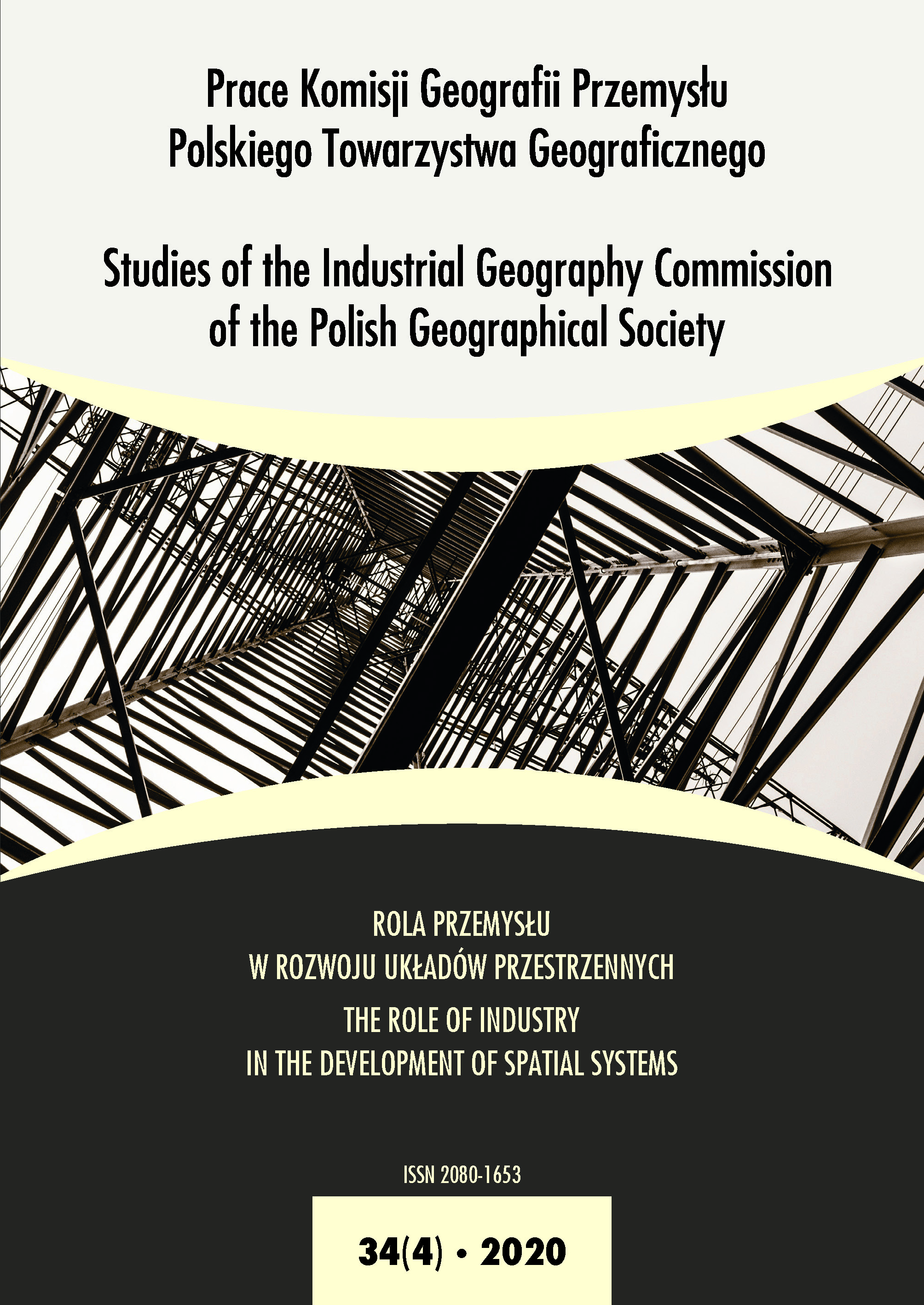Metallurgic industry in Europe in the years 1990–2020
DOI:
https://doi.org/10.24917/20801653.344.11Keywords:
aluminum, copper, metallurgy, nickel, steel, steelmaking, zinc and leadAbstract
Metallurgy is considered a key sector of any national economy and an important branch of heavy industry. It has strategic meaning for arms production and other industries and services. Its products are mostly used by construction industry, transportation means, infrastructure development and many services and other industrial sectors. Therefore, this paper documents changes in metallurgy in the years 1990-2020, when there were significant events, like communist states collapse with a change of their economic regimes, financial crisis, and the most significant technological progress in history. Collected data were compared on a basis of cartograms showing a distribution of metallurgical production in regional approach. Research includes whole European economy and shows many accompanying processes: globalization, regional economic integration, technological development, new resources exploration, and gradual closing down of old industrial hubs. The following products were analyzed: steel and pig iron, copper, ferroalloys, aluminum, zinc, lead and nickel. This article has supplementary figures showing geographical distribution of main metallurgical plants during last three decades which allows to formulate conclusions on the distribution of production.
Downloads
Metrics
References
Coccia, M. (2014). Steel market and global trends of leading geo-economic players. International Journal of trade and global markets, 7(1), 36–52.
Cvetkovski, S., Brkovski, D. (2014). The most important macedonian foundry companies. Machines. Technologies. Materials, 8(2), 3–8.
Dudin, M. N., Voykova, N. A., Frolova, E. E., Artemieva, J. A., Rusakova, E. P., Abashidze, A. H. (2017). Modern trends and challenges of development of global aluminum industry. Metalurgija, 56(1–2), 255–258.
Dunford, M., Greco, L. (2007). Geographies of growth, decline and restructuring: the rise and fall (privatization) of the state-owned steel sector and the trajectories of steel localities in the Italian Mezzogiorno. European Urban and Regional Studies, 14(1), 27–53.
Fabbio, M. D. (2011). Taranto and its steel production. Regional Insights, 2(1), 21–23.
Greco, L., Chiarello, F. (2016). The failure of regulation. Work, environment and production at Taranto’s ILVA. Economic and Industrial Democracy, 37(3), 517–534.
Escudero Gutiérrez, A. (2007). Bilbao was the ideal location for the Spanish iron and steel industry. BAGE: Boletín de la Asociación de Geógrafos Españoles, 44, 147–168.
Hendricks, C., Rasim, W., Janssen, H., Schnitzer, H., Sowka, E., Tesè, P. (1999). The casting rolling plant of Thyssen Krupp Stahl. Steel Times, 227(8), 306.
Hemker, J. (2017). The political economy of social policy implementation: evidence from the decentralization of the RMI in France. French Politics, 15(2), 187–222.
Hyseni, S., Durmishaj, B., Fetahaj, B., Large, D. (2010). Trepça ore belt and lead and zinc distribution in Badovc mineral deposit, Kosovo (SE Europe). Journal of Engineering and Applied Sciences, 5, 1–9.
Jakubowska, A., Grabowska-Powaga, A. (2017). Przejawy zmian instytucjonalnych w Polsce po roku 1989 – wybrane aspekty. Marketing i Rynek, 4 (CD), 122–131.
Levine, R. M., Brininstool, M., Wallace, G. J. (2007). The mineral industry of Ukraine. Minerals Yearbook, 3, 46.
Mayer, J., Bachner, G., Steininger, K. W. (2019). Macroeconomic implications of switching to process-emission-free iron and steel production in Europe. Journal of Cleaner Production, 210, 1517–1533.
Miernik, A. (2016). Polityka przemysłowa i przemysł w Polsce w okresie Polskiej Rzeczypospolitej Ludowej i III RP. Studia Ekonomiczne, Prawne i Administracyjne, 4, 58–82.
Misztal, S. (2003). Transformacja własnościowa działalności przemysłowej w Polsce według województw. Prace Komisji Geografii Przemysłu Polskiego Towarzystwa Geograficznego, 5, 9–30.
Mykhnenko, V. (2004). Rusting away? The Ukrainian Iron and Steel Industry in Transition. Open Society Institute Research Paper. Pozyskano z: https://core.ac.uk/download/pdf/11871163.pdf
Olson, E. L. (2018). Lead market learning in the development and diffusion of electric vehicles. Journal of Cleaner Production, 172, 3279–3288.
Orłowski, W. M. (2018). Konkurencyjność gospodarcza krajów. Propozycja alternatywnego pomiaru w kontekście dyskusji o konkurencyjności polskiej gospodarki. Studia BAS, 3, 9–28.
Özcan, G. B., Mondragon, A. E. C., & Harindranath, G. (2018). Strategic entry and operational integration of emerging market firms: The case of Cemex, Beko and Tata Steel in the UK. Journal of Business Research, 93, 242–254.
Pilarska, C. (2017). Międzynarodowa konkurencyjność gospodarki polskiej na tle nowych krajów członkowskich Unii Europejskiej. Kraków: Wydawnictwo Uniwersytetu Ekonomicznego (Monografie. Uniwersytet Ekonomiczny w Krakowie, 251).
Soroka, P. (2019). Deindustrializacja po 1989 roku i potrzeba reindustrializacji w Polsce. Przegląd Geopolityczny, 29, 9–24.
Santamaría, A., Linares, P., Pintos, P. (2014). The effects of carbon prices and anti-leakage policies on selected industrial sectors in Spain–Cement, steel and oil refining. Energy Policy, 65, 708–717.
Shatokha, V. (2016). The sustainability of the iron and steel industries in Ukraine. Challenges and opportunities. Journal of Sustainable Metallurgy, 2(2), 106–115.
Sivek, M., Kavina, P., Jirásek, J. (2019). New mineral policy of the Czech Republic of June 2017. Resources Policy, 60, 246–254.
Szulc, W., Garbarz, B., Paduch, J. (2011). Przebieg i wyniki restrukturyzacji przemysłu stalowego w Polsce. Prace Instytutu Metalurgii Żelaza, 4, 40–51.
USGS. (1996). Minerals Yearbook 1995. Washington, USGS.
USGS. (2006). Minerals Yearbook 2005. Washington, USGS.
USGS. (2016). Minerals Yearbook 2015. Washington, USGS.
Warrings, R., Fellner, J. (2018). Current status of circularity for aluminum from household waste in Austria. Waste Management, 76, 217–224.
Wiedermann, K. (2002). Restrukturyzacja i modernizacja hutnictwa żelaza Górnośląskiego Okręgu Przemysłowego po 1989 roku. Prace Komisji Geografii Przemysłu Polskiego Towarzystwa Geograficznego, 4, 115–128.
Wilczyński, P. L. (2019). Geografia przemysłu zbrojeniowego Europy. Kraków: Polskie Towarzystwo Geopolityczne.
Wyżnikiewicz, B. (2019). Konkurencyjność polskiej gospodarki i jej perspektywy na tle strefy euro. Studia BAS, 3, 131–151.
Zhuchkov, V. I., Zayakin, O. V. (2019). Manufacturing and Application of Complex Ferroalloys. KnE Materials Science, 138–144. doi: http://dx.doi.org/10.18502/kms.v5i1.3961
Zioło, Z., Rachwał, T. (2019). Przemiany przemysłu i jego otoczenia w układach przestrzennych. Prace Komisji Geografii Przemysłu Polskiego Towarzystwa Geograficznego, 33(4). doi:10.24917/20801653.334
Downloads
Published
How to Cite
Issue
Section
License
Articles are published under the terms of the Creative Commons License (CC BY-ND 4.0; Attribution– NoDerivs).

